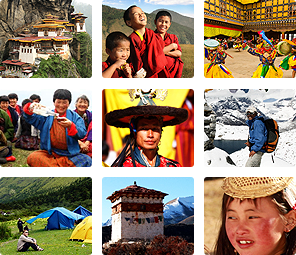The most distinct and important structures of Bhutan, Dzongs (fortresses) are the first sights to arrest the attention of any visitor to Bhutan. The Dzongs are architectural masterpieces and are as fascinating in their origin as their functions and beauty. These castle-like structures served as defensive fortresses and symbols of unity against external invasions and internal discord. It continues to function as a Bhutanese unity, identity, and strength. Regal and imposing, the Dzongs provide visitors a memorable experience with cultural value, historical significance, and magnificent structures.
Each site where the Dzongs stand was chosen to owe to their sacred significance in the places of natural beauty. Every Dzong is uniquely designed and in the way, it was chosen to be built in the first place. Many thrilling myths and legends encircle the Dzongs, just as devotees circle the Dzongs in prayer. They also carry the marks of civil wars and intrigues amongst the Bhutanese Lords. The Dzongs are the embodiment of the unification and identity of Bhutan. They were constructed in the distant past and are still multifunctional.
The tall central towers, Utse, signify the abstract frontiers between the spiritual and the temporal administrative mechanism of the dual system of government. The large courtyards of the fortresses symbolize its openness and broader approach to life. The expansion of territory is represented by the form and the expansiveness of the Dzongs. Thus, the presence of Dzongs embodies the recognition of the central authority by the people in the region. For the Bhutanese, these striking architectural marvels hark back to earlier times, to the source of law and order, peace, harmony, legitimate authority, the center of learning, strength, defence, festivity and social life.
The administrative bodies of a district would be housed within the Dzongs, as would monks. And the Dzongs were also places of trade and an area where people would congregate to celebrate, especially during the annual tshechu (festival), the masked dance festival. Visitors will never find the blueprints to any of these structures. The offering amply provides such an opportunity.
The Dzongs were built purely from the direction and dictation of a high Lama or Rinpoche spurred on by spiritual forces. The Dzongs house many treasures, particularly religious artefacts of great value, the monetary value is trivial when compared with the spiritual and cultural importance of these marvellous examples of Bhutanese heritage.
Besides, the traditional building structures such as historical places (monasteries and monuments) libraries, former prisons, bridges, ancient temples and museums across the country are also a popular tourist destination in the country. Many tourist attractions include zoos, botanical gardens, creative art and crafts workshops, handicraft shops, art galleries, public art, and cultural events. The national parks, mountains, and forests are examples of tourist attractions that people may visit.
-
Kyichu LhakhangView Details
-
Punakha Dzong – The Palace Of Great HappinessView Details
-
Ringpung Dzong – The Fortress Of The Heap Of JewelsView Details
-
Simtokha Dzong – The Fortress On Top Of The Demon’s StomachView Details
-
Taa Dzong – The National MuseumView Details
-
Taktsang Pelphug Monastery – The Tiger’s NestView Details







